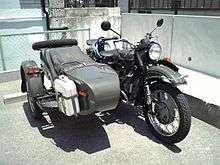Motorcycle
A motorcycle, often called a motorbike, bike, or cycle, is a two- or three-wheeled motor vehicle.[1] Motorcycle design varies greatly to suit a range of different purposes: long-distance travel, commuting, cruising, sport including racing, and off-road riding. Motorcycling is riding a motorcycle and related social activity such as joining a motorcycle club and attending motorcycle rallies.


The 1885 Daimler Reitwagen made by Gottlieb Daimler and Wilhelm Maybach in Germany was the first internal combustion, petroleum fueled motorcycle. In 1894, Hildebrand & Wolfmüller became the first series production motorcycle.[2][3]
In 2014, the three top motorcycle producers globally by volume were Honda (28%), Yamaha (17%) (both from Japan), and Hero MotoCorp (India).[4] In developing countries, motorcycles are considered utilitarian due to lower prices and greater fuel economy. Of all the motorcycles in the world, 58% are in the Asia-Pacific and Southern and Eastern Asia regions, excluding car-centric Japan.
According to the US Department of Transportation, the number of fatalities per vehicle mile traveled was 37 times higher for motorcycles than for cars.[5]
Types

The term motorcycle has different legal definitions depending on jurisdiction (see § Legal definitions and restrictions).
There are three major types of motorcycle: street, off-road, and dual purpose. Within these types, there are many sub-types of motorcycles for different purposes. There is often a racing counterpart to each type, such as road racing and street bikes, or motocross including dirt bikes.
Street bikes include cruisers, sportbikes, scooters and mopeds, and many other types. Off-road motorcycles include many types designed for dirt-oriented racing classes such as motocross and are not street legal in most areas. Dual purpose machines like the dual-sport style are made to go off-road but include features to make them legal and comfortable on the street as well.
Each configuration offers either specialised advantage or broad capability, and each design creates a different riding posture.
In some countries the use of pillions (rear seats) is restricted.
History
Experimentation and invention

The first internal combustion, petroleum fueled motorcycle was the Daimler Reitwagen. It was designed and built by the German inventors Gottlieb Daimler and Wilhelm Maybach in Bad Cannstatt, Germany in 1885.[6] This vehicle was unlike either the safety bicycles or the boneshaker bicycles of the era in that it had zero degrees of steering axis angle and no fork offset, and thus did not use the principles of bicycle and motorcycle dynamics developed nearly 70 years earlier. Instead, it relied on two outrigger wheels to remain upright while turning.[7]
The inventors called their invention the Reitwagen ("riding car"). It was designed as an expedient testbed for their new engine, rather than a true prototype vehicle.[8][9]
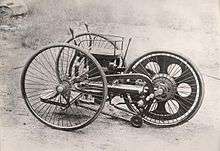
The first commercial design for a self-propelled cycle was a three-wheel design called the Butler Petrol Cycle, conceived of Edward Butler in England in 1884.[10] He exhibited his plans for the vehicle at the Stanley Cycle Show in London in 1884. The vehicle was built by the Merryweather Fire Engine company in Greenwich, in 1888.[11]
The Butler Petrol Cycle was a three-wheeled vehicle, with the rear wheel directly driven by a 5⁄8 hp (0.47 kW), 40 cc (2.4 cu in) displacement, 2 1⁄4 in × 5 in (57 mm × 127 mm) bore × stroke, flat twin four-stroke engine (with magneto ignition replaced by coil and battery) equipped with rotary valves and a float-fed carburettor (five years before Maybach) and Ackermann steering, all of which were state of the art at the time. Starting was by compressed air. The engine was liquid-cooled, with a radiator over the rear driving wheel. Speed was controlled by means of a throttle valve lever. No braking system was fitted; the vehicle was stopped by raising and lowering the rear driving wheel using a foot-operated lever; the weight of the machine was then borne by two small castor wheels. The driver was seated between the front wheels. It wasn't, however, a success, as Butler failed to find sufficient financial backing.[12]
Many authorities have excluded steam powered, electric motorcycles or diesel-powered two-wheelers from the definition of a 'motorcycle', and credit the Daimler Reitwagen as the world's first motorcycle.[13][14][15] Given the rapid rise in use of electric motorcycles worldwide,[16] defining only internal-combustion powered two-wheelers as 'motorcycles' is increasingly problematic. The first (petroleum fueled) internal-combustion motorcycles, like the German Reitwagen, were, however, also the first practical motorcycles.[14][17][18]
If a two-wheeled vehicle with steam propulsion is considered a motorcycle, then the first motorcycles built seem to be the French Michaux-Perreaux steam velocipede which patent application was filled in December 1868,[8][9] constructed around the same time as the American Roper steam velocipede, built by Sylvester H. Roper Roxbury, Massachusetts.[8][9] who demonstrated his machine at fairs and circuses in the eastern U.S. in 1867,[6] Roper built about 10 steam cars and cycles from the 1860s until his death in 1896.[15]
Summary of early inventions
| Year | Vehicle | Number of wheels | Inventor | Engine type | Notes |
|---|---|---|---|---|---|
| 1867–1868 | Michaux-Perreaux steam velocipede | 2 | Pierre Michaux Louis-Guillaume Perreaux | Steam |
|
| 1867–1868 | Roper steam velocipede | 2 | Sylvester Roper | Steam |
|
| 1885 | Daimler Reitwagen | 2 (plus 2 outriggers) | Gottlieb Daimler Wilhelm Maybach | Petroleum internal-combustion |
|
| 1887 | Butler Petrol Cycle | 3 (plus 2 castors) | Edward Butler | Petroleum internal-combustion | |
| 1894 | Hildebrand & Wolfmüller | 2 | Heinrich Hildebrand Wilhelm Hildebrand Alois Wolfmüller | Petroleum internal-combustion |
|
First motorcycle companies

In 1894, Hildebrand & Wolfmüller became the first series production motorcycle, and the first to be called a motorcycle (German: Motorrad).[8][9][15][19] Excelsior Motor Company, originally a bicycle manufacturing company based in Coventry, England, began production of their first motorcycle model in 1896. The first production motorcycle in the US was the Orient-Aster, built by Charles Metz in 1898 at his factory in Waltham, Massachusetts.
In the early period of motorcycle history, many producers of bicycles adapted their designs to accommodate the new internal combustion engine. As the engines became more powerful and designs outgrew the bicycle origins, the number of motorcycle producers increased. Many of the nineteenth-century inventors who worked on early motorcycles often moved on to other inventions. Daimler and Roper, for example, both went on to develop automobiles.
At the end of the 19th century the first major mass-production firms were set up. In 1898, Triumph Motorcycles in England began producing motorbikes, and by 1903 it was producing over 500 bikes. Other British firms were Royal Enfield, Norton and Birmingham Small Arms Company who began motorbike production in 1899, 1902 and 1910, respectively.[20] Indian began production in 1901 and Harley-Davidson was established two years later. By the outbreak of World War I, the largest motorcycle manufacturer in the world was Indian,[21][22] producing over 20,000 bikes per year.[23]
First World War
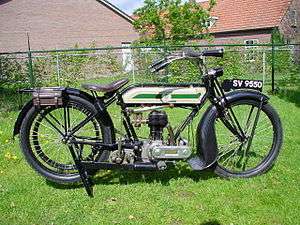
During the First World War, motorbike production was greatly ramped up for the war effort to supply effective communications with front line troops. Messengers on horses were replaced with despatch riders on motorcycles carrying messages, performing reconnaissance and acting as a military police. American company Harley-Davidson was devoting over 50% of its factory output toward military contract by the end of the war. The British company Triumph Motorcycles sold more than 30,000 of its Triumph Type H model to allied forces during the war. With the rear wheel driven by a belt, the Model H was fitted with a 499 cc (30.5 cu in) air-cooled four-stroke single-cylinder engine. It was also the first Triumph without pedals.[24]
The Model H in particular, is regarded by many as having been the first "modern motorcycle".[25] Introduced in 1915 it had a 550 cc side-valve four-stroke engine with a three-speed gearbox and belt transmission. It was so popular with its users that it was nicknamed the "Trusty Triumph".[26]
Postwar
By 1920, Harley-Davidson was the largest manufacturer,[27] with their motorcycles being sold by dealers in 67 countries.[28][29]
Amongst many British motorcycle manufacturers, Chater-Lea with its twin-cylinder models followed by its large singles in the 1920s stood out. Initially, using converted a Woodmann-designed ohv Blackburne engine it became the first 350 cc to exceed 100 mph (160 km/h), recording 100.81 mph (162.24 km/h) over the flying kilometre during April 1924.[7] Later, Chater-Lea set a world record for the flying kilometre for 350 cc and 500 cc motorcycles at 102.9 mph (165.6 km/h) for the firm. Chater-Lea produced variants of these world-beating sports models and became popular among racers at the Isle of Man TT. Today, the firm is probably best remembered for its long term contract to manufacture and supply AA Patrol motorcycles and sidecars.
By the late 1920s or early 1930s, DKW in Germany took over as the largest manufacturer.[30][31][32]
In the 1950s, streamlining began to play an increasing part in the development of racing motorcycles and the "dustbin fairing" held out the possibility of radical changes to motorcycle design. NSU and Moto Guzzi were in the vanguard of this development, both producing very radical designs well ahead of their time.[33] NSU produced the most advanced design, but after the deaths of four NSU riders in the 1954–1956 seasons, they abandoned further development and quit Grand Prix motorcycle racing.[34]
Moto Guzzi produced competitive race machines, and until the end of 1957 had a succession of victories.[35] The following year, 1958, full enclosure fairings were banned from racing by the FIM in the light of the safety concerns.
From the 1960s through the 1990s, small two-stroke motorcycles were popular worldwide, partly as a result of East German MZs Walter Kaaden's engine work in the 1950s.[36]
Today
In the 21st century, the motorcycle industry is mainly dominated by the Indian motorcycle industry and by Japanese motorcycle companies. In addition to the large capacity motorcycles, there is a large market in smaller capacity (less than 300 cc) motorcycles, mostly concentrated in Asian and African countries and produced in China and India. A Japanese example is the 1958 Honda Super Cub, which went on to become the biggest selling vehicle of all time, with its 60 millionth unit produced in April 2008.[37] Today, this area is dominated by mostly Indian companies with Hero MotoCorp emerging as the world's largest manufacturer of two wheelers. Its Splendor model has sold more than 8.5 million to date.[38] Other major producers are Bajaj and TVS Motors.[39]
Technical aspects
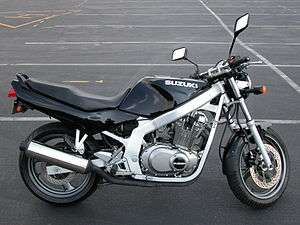
Construction
Motorcycle construction is the engineering, manufacturing, and assembly of components and systems for a motorcycle which results in the performance, cost, and aesthetics desired by the designer. With some exceptions, construction of modern mass-produced motorcycles has standardised on a steel or aluminium frame, telescopic forks holding the front wheel, and disc brakes. Some other body parts, designed for either aesthetic or performance reasons may be added. A petrol powered engine typically consisting of between one and four cylinders (and less commonly, up to eight cylinders) coupled to a manual five- or six-speed sequential transmission drives the swingarm-mounted rear wheel by a chain, driveshaft, or belt. Repair can be done using a Motorcycle lift.
Fuel economy
Motorcycle fuel economy varies greatly with engine displacement and riding style.[40] A streamlined, fully faired Matzu Matsuzawa Honda XL125 achieved 470 mpg‑US (0.50 L/100 km; 560 mpg‑imp) in the Craig Vetter Fuel Economy Challenge "on real highways – in real conditions."[41] Due to low engine displacements (100–200 cc (6.1–12.2 cu in)), and high power-to-mass ratios, motorcycles offer good fuel economy. Under conditions of fuel scarcity like 1950s Britain and modern developing nations, motorcycles claim large shares of the vehicle market.
Electric motorcycles
Very high fuel economy equivalents are often derived by electric motorcycles. Electric motorcycles are nearly silent, zero-emission electric motor-driven vehicles. Operating range and top speed are limited by battery technology.[42] Fuel cells and petroleum-electric hybrids are also under development to extend the range and improve performance of the electric drive system.
Reliability
A 2013 survey of 4,424 readers of the US Consumer Reports magazine collected reliability data on 4,680 motorcycles purchased new from 2009 to 2012.[43] The most common problem areas were accessories, brakes, electrical (including starters, charging, ignition), and fuel systems, and the types of motorcycles with the greatest problems were touring, off-road/dual sport, sport-touring, and cruisers.[43] There were not enough sport bikes in the survey for a statistically significant conclusion, though the data hinted at reliability as good as cruisers.[43] These results may be partially explained by accessories including such equipment as fairings, luggage, and auxiliary lighting, which are frequently added to touring, adventure touring/dual sport and sport touring bikes.[44] Trouble with fuel systems is often the result of improper winter storage, and brake problems may also be due to poor maintenance.[43] Of the five brands with enough data to draw conclusions, Honda, Kawasaki and Yamaha were statistically tied, with 11 to 14% of those bikes in the survey experiencing major repairs.[43] Harley-Davidsons had a rate of 24%, while BMWs did worse, with 30% of those needing major repairs.[43] There were not enough Triumph and Suzuki motorcycles surveyed for a statistically sound conclusion, though it appeared Suzukis were as reliable as the other three Japanese brands while Triumphs were comparable to Harley-Davidson and BMW.[43] Three fourths of the repairs in the survey cost less than US$200 and two thirds of the motorcycles were repaired in less than two days.[43] In spite of their relatively worse reliability in this survey, Harley-Davidson and BMW owners showed the greatest owner satisfaction, and three-fourths of them said they would buy the same bike again, followed by 72% of Honda owners and 60 to 63% of Kawasaki and Yamaha owners.[43]
Dynamics

Different types of motorcycles have different dynamics and these play a role in how a motorcycle performs in given conditions. For example, one with a longer wheelbase provides the feeling of more stability by responding less to disturbances.[45] Motorcycle tyres have a large influence over handling.
Motorcycles must be leaned in order to make turns. This lean is induced by the method known as countersteering, in which the rider momentarily steers the handlebars in the direction opposite of the desired turn. This practice is counterintuitive and therefore often confusing to novices – and even many experienced motorcyclists.[46][47][48]
With such short wheelbase, motorcycles can generate enough torque at the rear wheel, and enough stopping force at the front wheel, to lift the opposite wheel off the road. These actions, if performed on purpose, are known as wheelies and stoppies (or endos) respectively.
Accessories
Various features and accessories may be attached to a motorcycle either as OEM (factory-fitted) or aftermarket. Such accessories are selected by the owner to enhance the motorcycle's appearance, safety, performance, or comfort, and may include anything from mobile electronics to sidecars and trailers.
Records
- The world record for the longest motorcycle jump was set by Robbie Maddison with 107m (346 feet ).[49]
- Since late 2010, the Ack Attack team has held the motorcycle land-speed record at 376.36 mph (605.69 km/h).
Safety
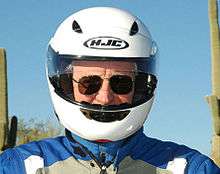
Motorcycles have a higher rate of fatal accidents than automobiles or trucks and buses. United States Department of Transportation data for 2005 from the Fatality Analysis Reporting System show that for passenger cars, 18.62 fatal crashes occur per 100,000 registered vehicles. For motorcycles this figure is higher at 75.19 per 100,000 registered vehicles – four times higher than for cars.[50] The same data shows that 1.56 fatalities occur per 100 million vehicle miles travelled for passenger cars, whereas for motorcycles the figure is 43.47 which is 28 times higher than for cars (37 times more deaths per mile travelled in 2007).[5] Furthermore, for motorcycles the accident rates have increased significantly since the end of the 1990s, while the rates have dropped for passenger cars.
The most common configuration of motorcycle accidents in the United States is when a motorist pulls out or turns in front of a motorcyclist, violating their right-of-way.[51] This is sometimes called a SMIDSY, an acronym formed from the motorists' common response of "Sorry mate, I didn't see you".[52] Motorcyclists can anticipate and avoid some of these crashes with proper training, increasing their visibility to other traffic, keeping to the speed limits, and not consuming alcohol or other drugs before riding.[53]
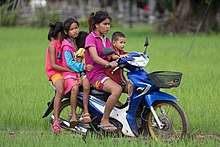
The United Kingdom has several organisations dedicated to improving motorcycle safety by providing advanced rider training beyond what is necessary to pass the basic motorcycle licence test. These include the Institute of Advanced Motorists (IAM) and the Royal Society for the Prevention of Accidents (RoSPA). Along with increased personal safety, riders with these advanced qualifications may benefit from reduced insurance costs [54]
In South Africa, the Think Bike campaign is dedicated to increasing both motorcycle safety and the awareness of motorcycles on the country's roads. The campaign, while strongest in the Gauteng province, has representation in Western Cape, KwaZulu Natal and the Free State. It has dozens of trained marshals available for various events such as cycle races and is deeply involved in numerous other projects such as the annual Motorcycle Toy Run.[55]
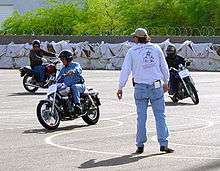
Motorcycle safety education is offered throughout the United States by organisations ranging from state agencies to non-profit organisations to corporations. Most states use the courses designed by the Motorcycle Safety Foundation (MSF), while Oregon and Idaho developed their own. All of the training programs include a Basic Rider Course, an Intermediate Rider Course and an Advanced Rider Course.
In Ireland, since 2010,[56] in the UK and some Australian jurisdictions, such as Victoria, New South Wales,[57] the Australian Capital Territory,[58] Tasmania[59] and the Northern Territory,[60] it is compulsory to complete a basic rider training course before being issued a Learners Licence, after which they can ride on public roads.
In Canada, motorcycle rider training is compulsory in Quebec and Manitoba only, but all provinces and territories have graduated licence programs which place restrictions on new drivers until they have gained experience. Eligibility for a full motorcycle licence or endorsement for completing a Motorcycle Safety course varies by province. Without the Motorcycle Safety Course the chance of getting insurance for the motorcycle is very low. The Canada Safety Council, a non-profit safety organisation, offers the Gearing Up program across Canada and is endorsed by the Motorcycle and Moped Industry Council.[61] Training course graduates may qualify for reduced insurance premiums.
Motorcycle rider postures
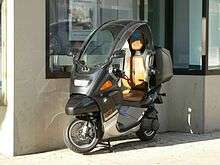
The motorcyclist's riding position depends on rider body-geometry (anthropometry) combined with the geometry of the motorcycle itself. These factors create a set of three basic postures.[62]
- Sport – the rider leans forward into the wind and the weight of the upper torso is supported by the rider's core at low speed and air pressure at high speed.[63] The footpegs are below the rider or to the rear. The reduced frontal area cuts wind resistance and allows higher speeds. At low-speed in this position the rider's arms may bear some of the weight of the rider's torso, which can be problematic.
- Standard – the rider sits upright or leans forward slightly. The feet are below the rider. These are motorcycles that are not specialised to one task, so they do not excel in any particular area.[64][65] The standard posture is used with touring and commuting as well as dirt and dual-sport bikes, and may offer advantages for beginners.[66]
- Cruiser – the rider sits at a lower seat height with the upper torso upright or leaning slightly rearward. Legs are extended forwards, sometimes out of reach of the regular controls on cruiser pegs. The low seat height can be a consideration for new or short riders. Handlebars tend to be high and wide. The emphasis is on comfort while compromising cornering ability because of low ground clearance and the greater likelihood of scraping foot pegs, floor boards, or other parts if turns are taken at the speeds other motorcycles can more readily accomplish.[67][68]
Factors of a motorcycle's ergonomic geometry that determine the seating posture include the height, angle and location of footpegs, seat and handlebars. Factors in a rider's physical geometry that contribute to seating posture include torso, arm, thigh and leg length, and overall rider height.
Legal definitions and restrictions
A motorcycle is broadly defined by law in most countries for the purposes of registration, taxation and rider licensing as a powered two-wheel motor vehicle. Most countries distinguish between mopeds of 49 cc and the more powerful, larger vehicles (scooters do not count as a separate category). Many jurisdictions include some forms of three-wheeled cars as motorcycles.
Environmental impact
Motorcycles and scooters' low fuel consumption has attracted interest in the United States from environmentalists and those affected by increased fuel prices.[69][70] Piaggio Group Americas supported this interest with the launch of a "Vespanomics" website and platform, claiming lower per-mile carbon emissions of 0.4 lb/mile (113 g/km) less than the average car, a 65% reduction, and better fuel economy.[71]
However, a motorcycle's exhaust emissions may contain 10–20 times more oxides of nitrogen (NOx), carbon monoxide, and unburned hydrocarbons than exhaust from a similar-year passenger car or SUV.[69][72] This is because many motorcycles lack a catalytic converter, and the emission standard is much more permissive for motorcycles than for other vehicles.[69] While catalytic converters have been installed in most gasoline-powered cars and trucks since 1975 in the United States, they can present fitment and heat difficulties in motorcycle applications.[69]
United States Environmental Protection Agency 2007 certification result reports for all vehicles versus on highway motorcycles (which also includes scooters),[73] the average certified emissions level for 12,327 vehicles tested was 0.734. The average "Nox+Co End-Of-Useful-Life-Emissions" for 3,863 motorcycles tested was 0.8531. 54% of the tested 2007-model motorcycles were equipped with a catalytic converter.
United States emissions limits
The following table shows maximum acceptable legal emissions of the combination of hydrocarbons, oxides of nitrogen, and carbon monoxide for new motorcycles sold in the United States with 280 cc or greater piston displacement.[74]
| Tier | Model year | HC+NOx (g/km) | CO (g/km) |
|---|---|---|---|
| Tier 1 | 2006–2009 | 1.4 | 12.0 |
| Tier 2 | 2010 and later | 0.8 | 12.0 |
The maximum acceptable legal emissions of hydrocarbon and carbon monoxide for new Class I and II motorcycles (50 cc–169 cc and 170 cc–279 cc respectively) sold in the United States are as follows:[74]
| Model year | HC (g/km) | CO (g/km) |
|---|---|---|
| 2006 and later | 1.0 | 12.0 |
Europe
European emission standards for motorcycles are similar to those for cars.[75] New motorcycles must meet Euro 4 standards,[76] while cars must meet Euro 6D-temp standards. Motorcycle emission controls are being updated and it has been proposed to update to Euro 5 in 2020.[77]
See also
Notes
-
- "Definition of Motorcycle by Merriam-Webster". merriam-webster. Retrieved 17 March 2016.
- Foale, Tony (2006). Motorcycle Handling and Chassis Design. Tony Foale Designs. pp. 4–1. ISBN 978-84-933286-3-4.
- "Bureau of Motor Vehicles". BMV. Retrieved 17 March 2016.
- Cossalter, Vittore (2006). Motorcycle Dynamics. Lulu. ISBN 978-1-4303-0861-4.
- "cycle". Oxford English Dictionary (3rd ed.). Oxford University Press. September 2005. (Subscription or UK public library membership required.)
- "Motorcycle Timeline - Evolution of Motorcycles". www.bicyclehistory.net.
- "Hildebrand & Wolfmuller Motorcycle, circa 1894 - The Henry Ford". www.thehenryford.org.
- "Top Five Global Motorcycle Companies: Performance, Strategies and Competitive Analysis". researchandmarkets.com. August 2013. Retrieved 24 January 2016.
- "Traffic safety facts, 2008. Report no. DOT HS-811-159" (PDF). NHTSA's National Center for Statistics and Analysis. 2008. Retrieved 15 September 2010.
- "The Past – 1800s: First motorcycle". The History and Future of Motorcycles and motorcycling – From 1885 to the Future, Total Motorcycle Website. Retrieved 28 June 2007.
- Lienhard 2005, pp. 120-121.
- Setright 1979.
- Falco 1999.
- "motorcycle (vehicle)". Encyclopædia Britannica.
- Georgano 2002, p. 22.
- Georgano 2002, pp. 20-22.
- "motorcycle, n.". Oxford English Dictionary Online. Oxford University Press. March 2009.
1. A two-wheeled motor-driven road vehicle, resembling a bicycle but powered by an internal-combustion engine; (now) spec. one with an engine capacity, top speed, or weight greater than that of a moped.
- Long, Tony (30 August 2007). "Aug. 30, 1885: Daimler Gives World First 'True' Motorcycle". Wired. ISSN 1059-1028.
- Kresnak 2008.
- "Electric Bikes Drive Global Sales". 24 December 2014. Retrieved 5 March 2015.
- Barnum, Merritt H. (August 1963). "New Image in Motorcycling". American Motorcyclist. 17: 5. ISSN 0277-9358.
- Wineland, Lynn (1964). The Complete Book of Motorcycling. Petersen Publishing Company. p. 7. ASIN B0007E0SN8.
- "Brief History of the Marque: Hildebrand & Wolfmuller". Hildebrand & Wolfmuller Motorad, European Motorcycle Universe. Retrieved 28 June 2007.
- "History of Motorbikes". Bikes4Sale.
- Walker 2006, p. 66.
- George Hendee. The AMA Motorcycle Hall of Fame Museum. Retrieved 8 August 2009.
- Youngblood, Ed (June 2001). "The Rise and Fall". American Motorcyclist. 55 (6). American Motorcyclist Assoc.
- "Triumph history". Archived from the original on 8 September 2008. Retrieved 20 May 2009.
- "Triumph Motorcycle History". Archived from the original on 21 March 2015. Retrieved 18 November 2013.
- Chadwick, Ian. "Triumph Motorcycles timeline".
- "History of Harley-Davidson Motor Company". pcmotors.com.
- Prashad, Sharda (16 April 2006). "HOG WILD; U of T professor Brendan Calder is one of the legions of baby boomers who have helped to ensure the success of the Harley-Davidson brand name, not to mention its bottom line". Toronto Star. Toronto, Ont. p. A.16.
- Cato, Jeremy (8 August 2003). "Harley-Davidson at 100". The Vancouver Sun. Vancouver, B.C. p. E.1.Fro.
- Vance, Bill (24 April 2009). "Motoring Memories: DKW/Auto Union, 1928–1966". Canadian Driver.
- de Cet 2002, p. 128.
- Walker 1999, p. 61.
- Willoughby 1982.
- "Rupert Hollaus". Motorsport Memorial. Retrieved 3 April 2008.
- "Moto Guzzi History". Moto Guzzi. Retrieved 23 February 2019.
- Youngblood, Ed. "Motocross goes International, 1947 through 1965". The History of Motocross, Part Two, Motorcycle Hall of Fame Museum. Archived from the original on 13 November 2007. Retrieved 29 June 2007.
- Squatriglia, Chuck (23 May 2008). "Honda Sells Its 60 Millionth – Yes, Millionth – Super Cub". Autopia. Wired. Retrieved 28 January 2010.
- "Hero Honda splendor sells more than 8.5 million units". indiacar.net. Archived from the original on 21 February 2008. Retrieved 10 August 2008.
- O'Malley Greenburg, Zack (13 August 2007). "World's Cheapest Car". Forbes. Retrieved 28 January 2010.
- "Motorcycle Fuel Consumption & Real World Performance Guide". MFC Website. Archived from the original on 18 July 2008. Retrieved 13 June 2008.
- Vetter, Craig. "Doing More with Less Energy". The Craig Vetter Fuel Economy Contests – 1980 through 1985. Archived from the original on 22 August 2006. Retrieved 15 August 2006.
- "Electric Motorcycles". Solo Moto. Retrieved 15 May 2016.
- "Most reliable motorcycles; Japanese bikes have fewer problems than BMW and Harley models", Consumer Reports, May 2013, retrieved 26 March 2013
- Bartlett, Jeff (26 March 2013), "Motorcycle reliability survey shows what goes wrong", Consumer Reports, retrieved 26 March 2013
- Gaetano 2004, pp. 34-25 "[W]ith the same disturbance, the rider with a longer wheelbase will feel less oscillating movement on the handlebars, and therefore, will have a perception of greater stability on the motorcycle."
- Joel Fajans (July 2000). "Steering in bicycles and motorcycles" (PDF). American Journal of Physics. 68 (7): 654–59. Bibcode:2000AmJPh..68..654F. doi:10.1119/1.19504. Retrieved 4 August 2006.
- Hurt, H.H.; Ouellet, J.V.; Thom, D.R (January 1981). "Motorcycle Accident Cause Factors and Identification of Countermeasures, Volume 1: Technical Report" (PDF). U.S. Department of Transportation, NHTSA. Archived from the original (PDF) on 23 August 2014. Cite journal requires
|journal=(help) - Crouch, Tom D. (1989). The Bishop's Boys. New York: W. W. Norton. p. 170. ISBN 0-393-30695-X.
- "Jump record". Jump record.
- "Vehicles Involved in Fatal Crashes, 1994–2011 – State: USA". Fatality Analysis Reporting System. United States Department of Transportation. Retrieved 18 May 2014.
- "MOTORCYCLE ACCIDENT CAUSE FACTORS AND IDENTIFICATION OF COUNTERMEASURES VOLUME I: TECHNICAL REPORT, Traffic Safety Center - University of Southern California" (PDF). 1981. p. 416. Archived from the original (PDF) on 23 August 2014.
- "The 'sorry mate I didn't see you' campaign". South Gloucestershire Council. Archived from the original on 17 October 2008. Retrieved 21 May 2008.
- Quick Tips: General guidelines for riding a motorcycle safely (PDF), Motorcycle Safety Foundation, October 2006, retrieved 13 June 2012
- "Motorcycling : THINK! : Roadsafety". think.direct.gov.uk. Retrieved 1 June 2016.
- "About Think Bike". Think Bike. Retrieved 21 March 2010.
- "GDL rollout". Road Safety Association of Ireland. Retrieved 15 August 2015.
- "Learner riders licence". Motorcycle Rider Training Scheme, Roads and Traffic Authority, NSW. Retrieved 16 May 2007.
- "Learner Licence". Road Transport Information Management, www.rego.act.gov.au. Retrieved 16 May 2007.
- "TAS Learner Licence". Department of Infrastructure, Energy and Resources. Archived from the original on 11 June 2009. Retrieved 13 June 2009.
- "Motorcyclist Education Training And Licensing (METAL)". Northern Territory Department of Planning and Infrastructure, www.ipe.nt.gov.au. Archived from the original on 7 May 2007. Retrieved 16 May 2007.
- "MMIC Information". Motorcycle and Moped Industry Council. Retrieved 16 May 2007.
- "A Three Dimensional Analysis of Riding Posture in Three Different Styles of Motorcycle" (PDF). Motorcycle Safety Foundation. March 2006. Archived from the original (PDF) on 27 March 2012. Retrieved 31 January 2008.
- Davis & Anthony 2011, p. 25 "The [sportbike] rider posture is usually canted severely forwrd with his hands pressing onto the handlebar grips, which are designed to keep him over the gasoline tank, a position not intended to maximize comfort. This posture is aerodynamically efficient at high speeds, when wind assists the rider by supporting his body, but at lower speeds quickly results in rider fatigue and stressed wrists."
- Maher & Greisler 1998.
- Duglin Kennedy 2005, p. 75.
- Stermer 2006, p. 16.
- Stermer 2006, p. 10.
- Duglin Kennedy 2005, p. 71.
- Carpenter, Susan (11 June 2008). "Motorcycles and emissions: The surprising facts". LA Times. Retrieved 8 August 2008.
- Dahl, Judy (September 2007). "Baby, You Can Drive My Vespa". Madison Magazine. Archived from the original on 11 October 2007. Retrieved 8 August 2008.
- "Vespanomics – Vespa Economics" (PDF). Piaggio Group USA. Retrieved 8 February 2010.
- Fisk, Umbra (28 May 2003). "On motorcycles – Ask Umbra". Grist.
- "Certified Highway Motorcycle Test Result Report Data (2007)". US EPA. 8 January 2008.
- "EPA Emissions Regulations for 1978 and Later New Motorcycles, General Provisions". United States Environmental Protection Agency. Retrieved 7 December 2013.
- Leonidas, Ntziachristos; Savas, Geivanidis; Zissis, Samaras; Anastasios, Xanthopoulos; Heinz, Steven; Bernd, Bugsel (September 2009). "Study on possible new measures concerning motorcycle emissions" (PDF): 16. Cite journal requires
|journal=(help) - Madson, Bart (15 February 2007). "Motorcycle Emissions Regs Examined". Motorcycle-USA.com. Retrieved 28 January 2010.
- "EURO 5 Cycle Emissions Proposed for 2015". Dealernews.com. 8 December 2008. Archived from the original on 17 February 2015. Retrieved 28 January 2010.
References
- de Cet, Mirco (2002), The illustrated directory of motorcycles, MotorBooks/MBI Publishing Company, ISBN 978-0-7603-1417-3
- Davis, James R.; Anthony, Cash (2011), Motorcycle Safety and Dynamics: Vol 1, Houston, Texas: Master Strategy Group, ISBN 978-1257645886
- Falco, Charles M.; Guggenheim Museum Staff (1998), "Issues in the Evolution of the Motorcycle", in Krens, Thomas; Drutt, Matthew (eds.), The Art of the Motorcycle, Harry N. Abrams, pp. 24–31, ISBN 0-89207-207-5
- Gaetano, Cocco (2004), Motorcycle Design and Technology, Minneapolis: MotorBooks/MBI Publishing Company, ISBN 978-0-7603-1990-1
- Georgano, G.N. (2002), Early and Vintage Years, 1885-1930: The Golden Era of Coachbuilding, Mason Crest Publishers
- Kresnak, Bill (2008), Motorcycling for Dummies, Hoboken, New Jersey: For Dummies, Wiley Publishing, ISBN 978-0-470-24587-3
- Lienhard, John H. (2005), Inventing Modern: Growing Up with X-Rays, Skyscrapers, and Tailfins, Oxford University Press US, ISBN 0-19-518951-5
- Maher, Kevin; Greisler, Ben (1998), Chilton's Motorcycle Handbook, Haynes North America, pp. 2.2–2.18, ISBN 0-8019-9099-8
- Setright, L.J.K. (1979), The Guinness book of motorcycling facts and feats, Guinness Superlatives, pp. 8–18, ISBN 978-0-85112-200-7
- Stermer, Bill (2006), Streetbikes: Everything You Need to Know, MotorBooks/MBI Publishing Company, ISBN 978-0-7603-2362-5
- Duglin Kennedy, Shirley (2005), The Savvy Guide to Motorcycles, Indy Tech Publishing, ISBN 978-0-7906-1316-1
- Walker, Mick (1999). Mick Walker's German Racing Motorcycles. Redline Books. ISBN 978-0-9531311-2-9.
- Walker, Mick (2006), Motorcycle: Evolution, Design, Passion, JHU Press, ISBN 978-0-8018-8530-3
- Willoughby, Vic (1982), Exotic Motorcycles, London: Osprey Publishing, Ltd, ISBN 0-85045-322-4
External links
| Wikimedia Commons has media related to Motorcycle. |
| Wikivoyage has a travel guide for Motorcycling. |

